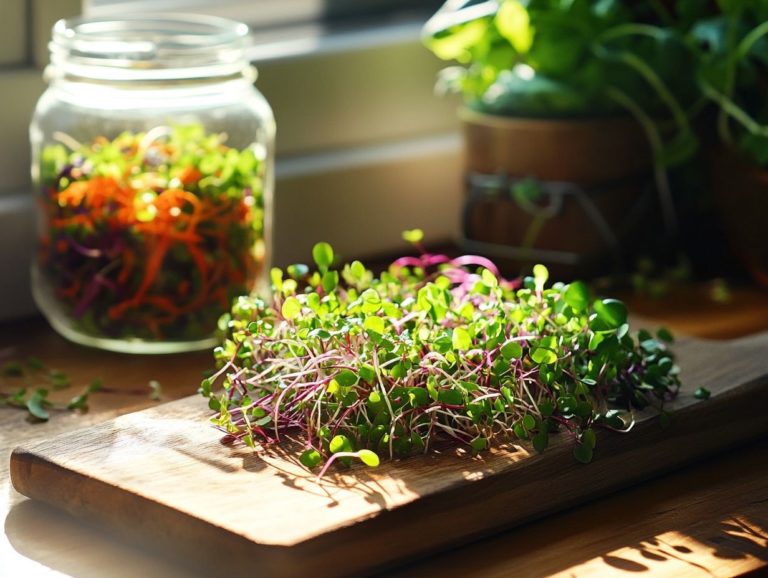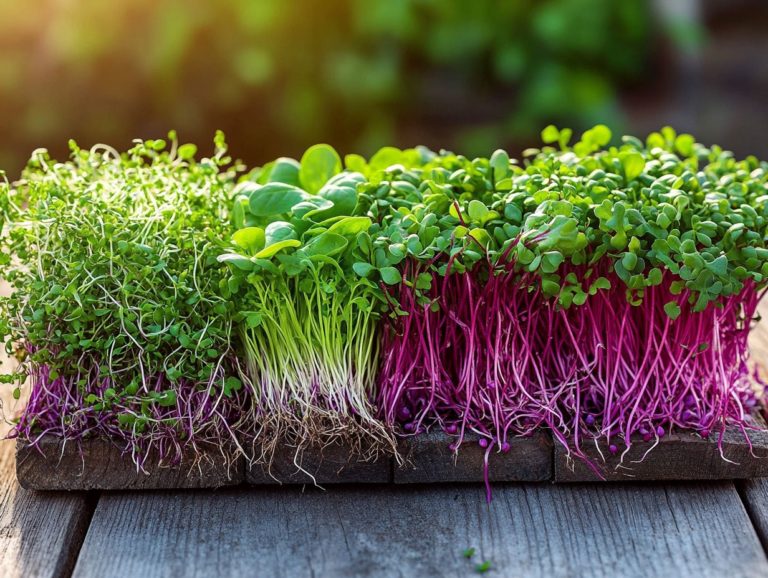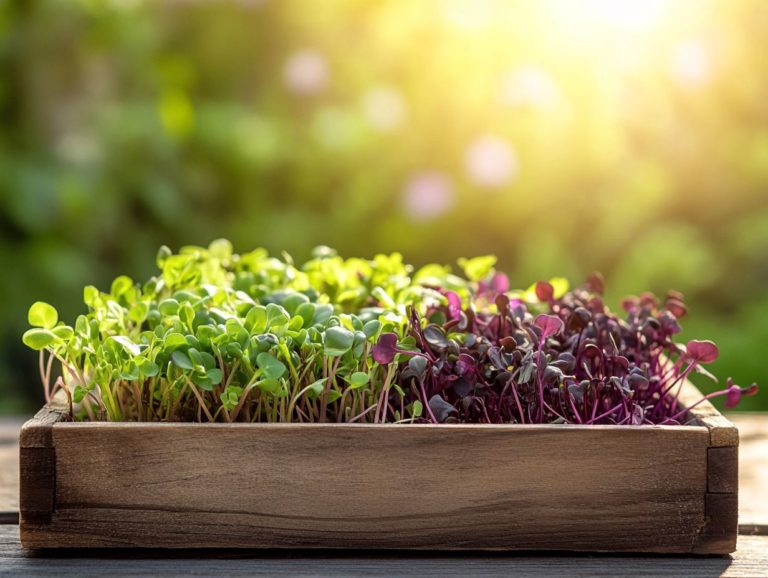The Health Benefits of Growing Your Own Microgreens
Microgreens are tiny, flavorful greens packed with nutrients. They are a sought-after addition to diets worldwide.
But what exactly are they, and why should you consider growing your own? This article unpacks the definition and types of microgreens. It dives into their health and environmental benefits and provides you with a step-by-step guide for cultivating them right at home.
You ll discover how nutritious microgreens are compared to mature greens. Explore delicious ways to add them to your meals. Plus, you ll receive tips to sidestep common growing pitfalls.
Uncover how these small powerhouses can elevate your diet and enrich your lifestyle!
Contents
Key Takeaways:
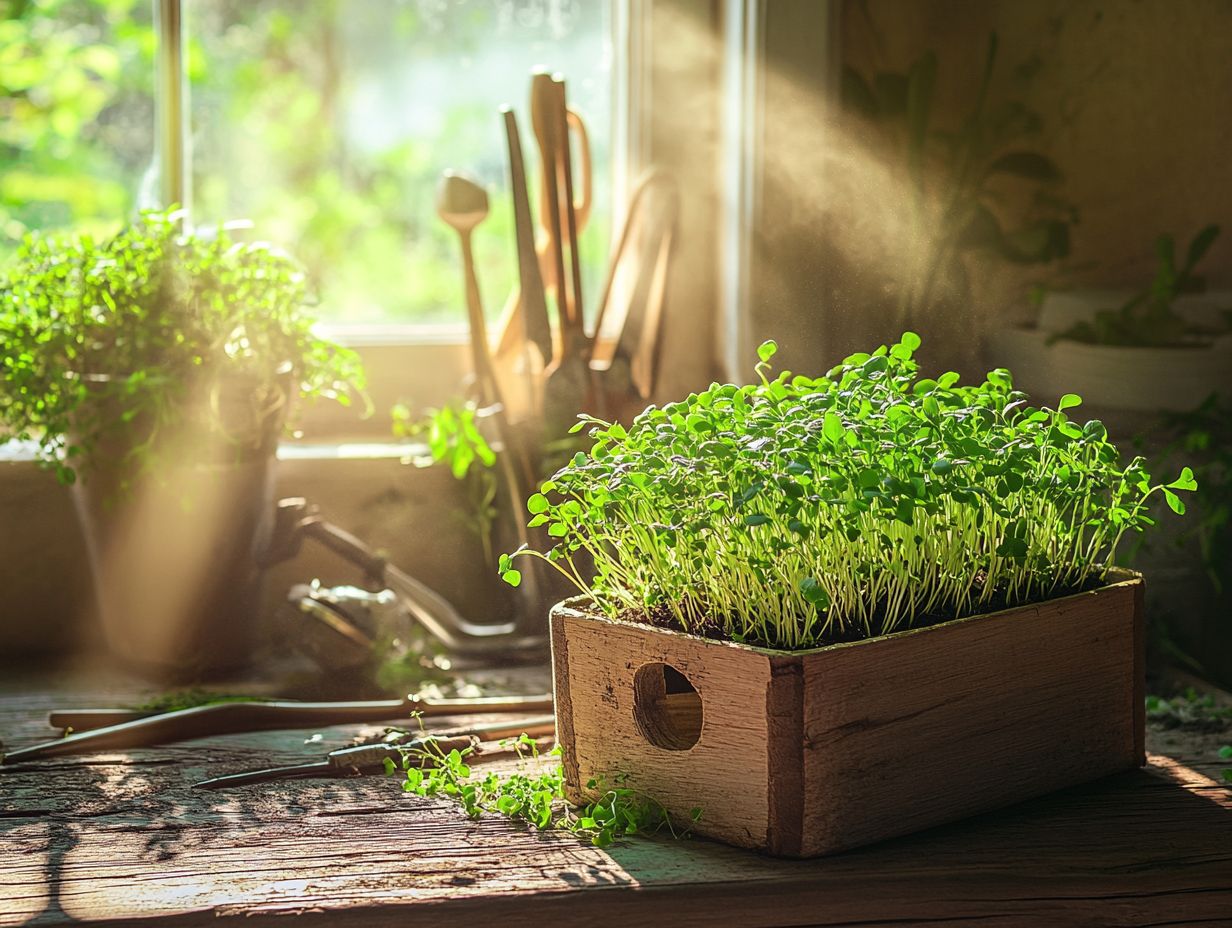
- Growing your own microgreens can have both positive environmental and health benefits, making it a sustainable and nutritious addition to your diet.
- Microgreens are packed with essential vitamins, minerals, and antioxidants, often more nutrient-dense than their mature counterparts.
- Incorporating microgreens into your diet is easy and versatile. You can grow them at home with a simple step-by-step guide.
What are Microgreens?
Microgreens are not just tiny plants; they’re healthy foods that have become the superfoods everyone is talking about. These vibrant, young greens are harvested right after the first true leaves emerge, and they don t just look good on your plate they re also bursting with vitamins, minerals, and antioxidants.
You ll find popular varieties like broccoli, arugula, radish, sunflower, spinach, pak choi, and beets on many health enthusiasts’ lists. Their cultivation has surged in popularity among home gardeners eager to elevate their diets with fresh, health-boosting ingredients.
Definition and Types
Microgreens, those delightful young greens harvested at their peak, come in an impressive variety, each one boasting distinct flavors and health benefits. You ll find everything from the peppery kick of arugula to the sweet nuances of basil among these tiny culinary gems.
Beyond their vibrant taste profiles, microgreens are nutritional powerhouses. They often contain higher concentrations of vitamins, minerals, and antioxidants compared to their fully grown counterparts, making them a boon for your health. To learn more about their advantages, check out the health benefits of microgreens explained.
Take popular varieties like radish greens and broccoli microgreens, for instance. They’re not just scrumptious additions to your salads and sandwiches; they also offer specific health benefits. For more insights, check out the top microgreen varieties for health enthusiasts, which include potential anti-inflammatory properties and ways to boost your immune system.
Why Grow Your Own Microgreens?
Start growing your own microgreens today! They offer amazing health benefits and turn gardening into a fun and easy experience. These tiny nutritional powerhouses are packed with essential vitamins and minerals, and their ease of cultivation makes them a fantastic addition to any diet.
By nurturing microgreens at home, you can enjoy fresh greens whenever you desire, enhancing your gut health and bolstering your immune system in the process.
Environmental and Health Benefits
The environmental and health benefits of growing microgreens are truly remarkable. These tiny greens are packed with nutrients, boasting up to 40 times the vitamins and minerals found in their fully grown counterparts.
By simply incorporating microgreens into your daily meals, you can effortlessly enhance your intake of vitamins A, C, and K key players in bolstering your immune system and promoting overall wellness.
Cultivating them at home is a breeze, requiring far less water and space compared to traditional farming methods. This means your environmental footprint shrinks significantly. Plus, this practice encourages self-sufficiency and reduces your reliance on mass-produced food, which often comes with a side of harmful pesticides and fertilizers. For added benefits, consider exploring unlocking the antioxidant power of microgreens to enhance your health.
In short, growing microgreens is an innovative solution for health-conscious individuals like you while also making a positive impact on the planet. To understand more about this process, explore the science behind microgreen growth.
How to Grow Microgreens at Home

Growing microgreens at home is simple and rewarding. Anyone can start, regardless of their gardening experience. With the right approach and a touch of patience, you can cultivate an array of these nutrient-rich plants right in your kitchen or garden.
This step-by-step guide will lead you through the essential processes, ensuring your success in both growth and harvesting. You ll be rewarded with a continuous supply of fresh, health-boosting ingredients at your fingertips.
Step-by-Step Guide
A step-by-step guide to growing microgreens can empower you, whether you’re a novice or a seasoned gardener, to successfully cultivate these nutritious plants right in your home.
With clear instructions at your fingertips, you can seamlessly navigate the entire process, beginning with selecting the right seeds that align with your taste and nutritional preferences. Consider factors like the time it takes for seeds to sprout and flavor profiles, as these choices will elevate your meal preparation experience.
Choose the right growing medium, the material in which plants grow, such as soil or water, to support optimal growth. Once you ve planted the seeds, maintaining suitable lighting and moisture levels becomes crucial for ensuring healthy development.
Timing your harvest is key; it brings the ultimate freshness and flavor to your culinary creations, showcasing just how easy and rewarding cultivating microgreens can truly be.
Nutritional Value of Microgreens
Microgreens are becoming popular for their amazing health benefits, often boasting higher concentrations of vitamins, minerals, and antioxidants than their fully matured counterparts. These diminutive plants serve as a rich source of dietary fiber and are loaded with health-enhancing compounds that can aid in lowering cholesterol, improving blood pressure, and elevating overall well-being.
Understanding the nutritional differences can empower you to make healthier food choices.
Comparison to Mature Greens
When you compare microgreens to mature greens, you’ll quickly realize that microgreens often pack a higher nutritional punch in a more compact form.
Take varieties like broccoli and radish, for example; they flaunt significantly higher levels of vitamin C, vitamin E, and various B vitamins. They re also a rich source of antioxidants, including flavonoids, which can contribute to your overall health and may help reduce inflammation.
Plus, the essential minerals iron, magnesium, and potassium are often more concentrated in microgreens, transforming them into not just a flavorful addition to your meals, but a true nutritional powerhouse. For more insights, check out the impact of microgreens on overall wellbeing.
Ways to Incorporate Microgreens into Your Diet
Start incorporating microgreens into your diet today! They are an easy and delicious way to boost your meals with nutrients. These petite greens can seamlessly fit into a variety of dishes, from vibrant salads and hearty sandwiches to refreshing smoothies and elegant garnishes, making them a versatile staple for health-conscious culinary enthusiasts.
By embracing the creative possibilities of cooking with microgreens, you not only enhance the visual appeal of your meals but also introduce a rich source of dietary fiber and other health-boosting elements into your daily fare. Discover why microgreens are superfoods you need for a nutritious boost.
Recipes and Ideas
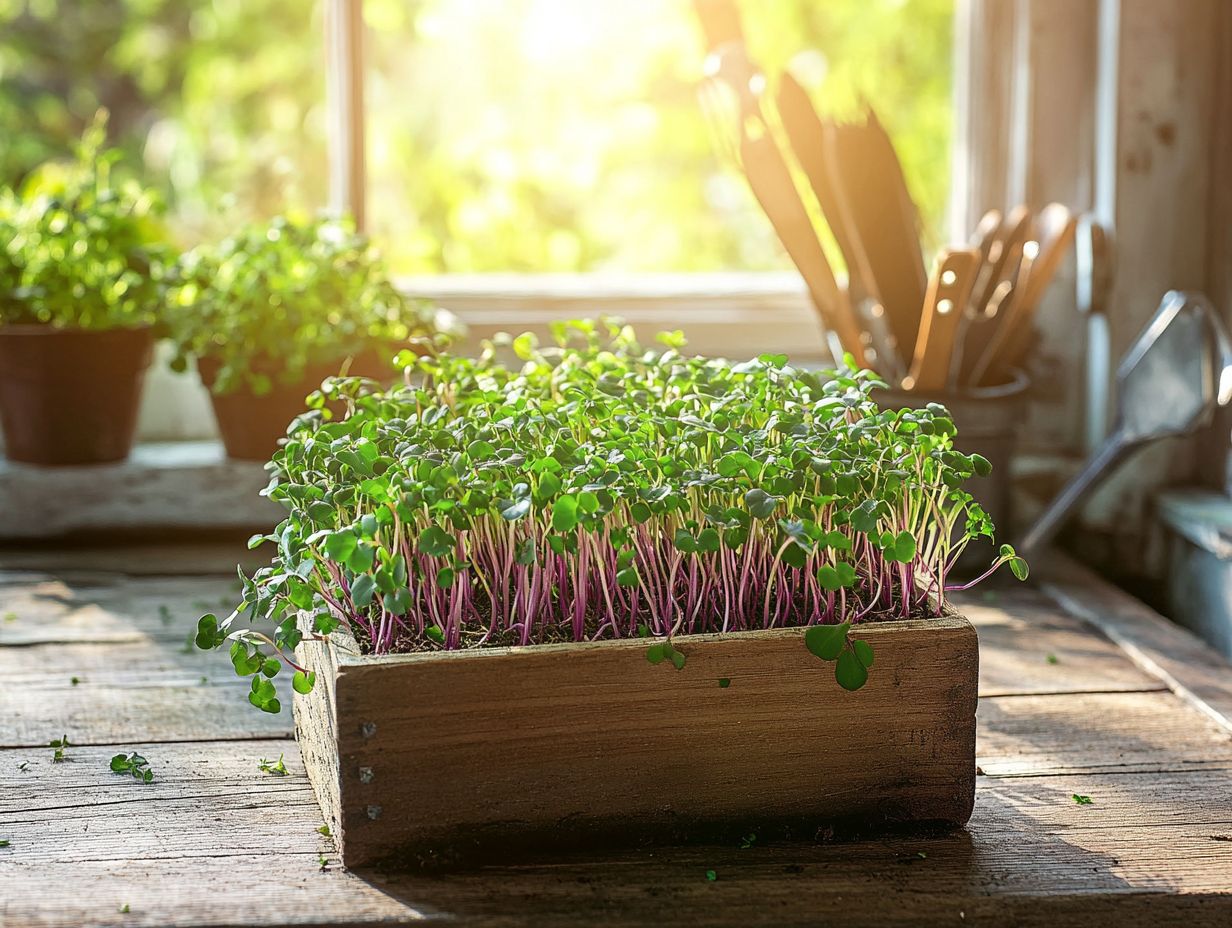
Exploring various recipes and ideas for incorporating microgreens into your meals opens up a world of culinary creativity just waiting for you to dive in.
These amazing little greens, bursting with flavor and nutrients, can truly invigorate your salads, sandwiches, and smoothies. Whether it’s the peppery kick of arugula or the sweetness of pea shoots, each variety brings a unique taste profile that enhances the visual appeal of your dishes while elevating their health benefits. Discovering why microgreens are essential for a balanced diet can further inspire your culinary creations.
For example, adding sunflower microgreens to a hearty grain bowl introduces a delightful crunch and an extra dose of protein. Think about using basil microgreens as a refreshing garnish for soups or to elevate your pizza game. Exploring the role of microgreens in healthy eating can also enhance your meals with added nutrients.
The versatility of these nutrient-rich greens makes them essential in any kitchen. Whether you’re a home cook or a food lover, these greens invite your creativity while promoting a healthier lifestyle. To learn more about their benefits, check out the science behind microgreens and health.
Common Mistakes to Avoid When Growing Microgreens
When you embark on the journey of growing microgreens, it s essential to recognize the common mistakes that could impede your success. While these tiny plants are relatively easy to cultivate, they can encounter challenges like improper watering, insufficient light, and pest infestations.
By familiarizing yourself with these potential pitfalls and employing effective troubleshooting strategies, you can ensure a fruitful growing experience and fully reap the health benefits that microgreens have to offer.
Troubleshooting Tips
Troubleshooting tips can be invaluable as you navigate the journey of growing microgreens. They help you identify and correct common mistakes along the way.
As a novice gardener, you might grapple with issues like inadequate lighting, overwatering, or pesky infestations that stifle your microgreens’ growth. Keeping a close eye on your seedlings can reveal if they’re getting leggy due to insufficient light or if damp soil is leading to root rot. Additionally, understanding the nutritional advantages of microgreens for kids can motivate you to overcome these challenges.
Using a simple watering schedule and opting for well-draining soil helps reduce these challenges significantly. Introducing airflow around your plants can also be a game-changer in combating mold and pests.
By tackling these typical hurdles early on, you can cultivate vibrant, healthy microgreens that flourish under your care.
Frequently Asked Questions
What are microgreens?
Wondering what microgreens are? They’re young, edible greens harvested at the cotyledon stage, just a few weeks after germination. Packed with nutrients, they’re known for their intense flavor and vibrant colors.
Why should I grow my own microgreens?
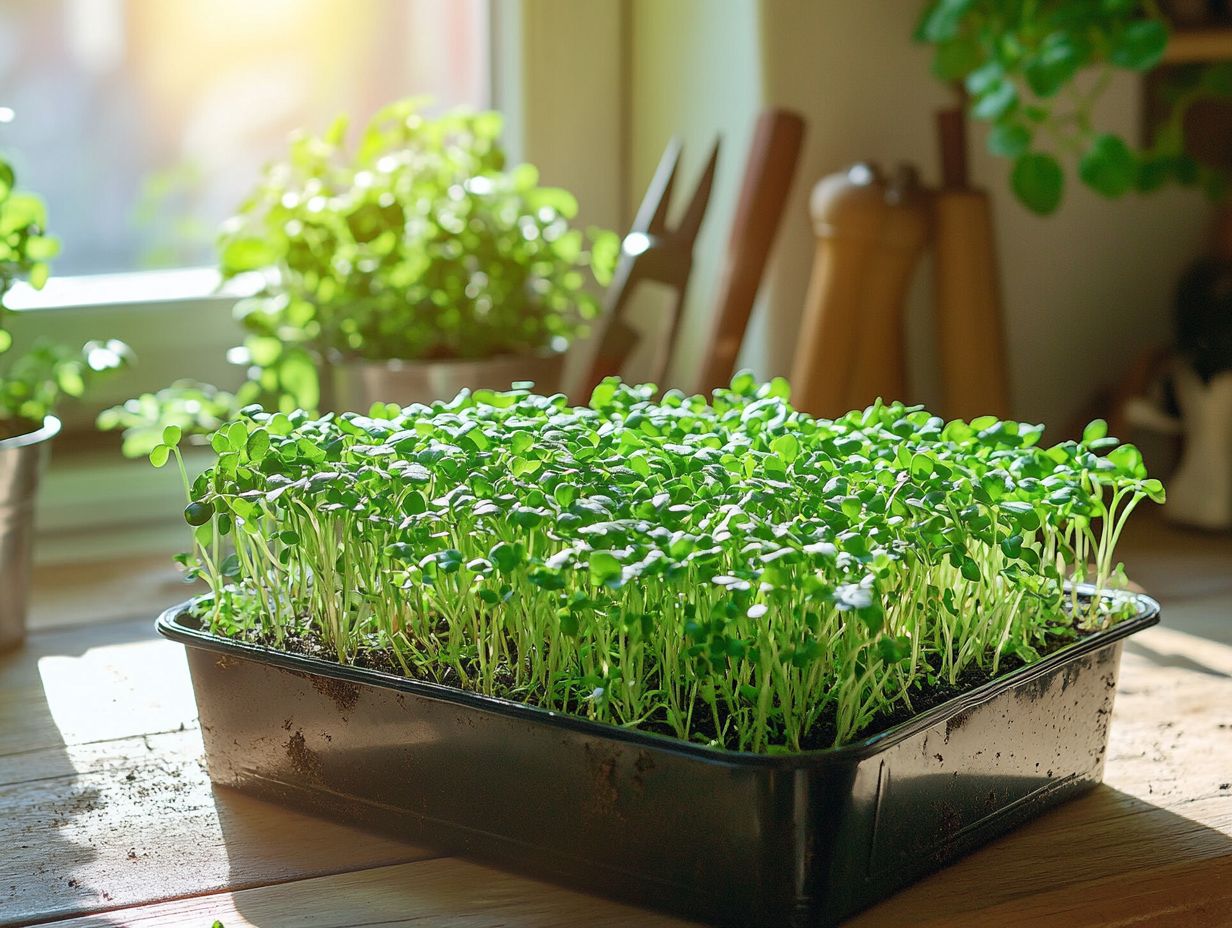
Growing your own microgreens allows you to have a fresh and constant supply of nutritious greens right at your fingertips. They’re easy to grow, require little space, and can be harvested as needed.
What are the health benefits of microgreens?
Microgreens are packed with vitamins, minerals, and antioxidants, making them a fantastic addition to any diet. They also contain high levels of enzymes and phytochemicals, which can help boost your immune system and prevent chronic diseases.
Can microgreens help with weight loss?
Yes, microgreens can be a great addition to a weight loss diet. They’re low in calories but high in nutrients, making them a filling and nutritious option for those looking to shed pounds.
How do I incorporate microgreens into my meals?
Microgreens can be used in various ways, from topping salads and sandwiches to adding them to smoothies and soups. Get creative and experiment with different dishes to find your favorite way to enjoy them!
Are there any risks to growing microgreens at home?
Growing microgreens at home is generally safe, but it’s important to follow proper hygiene and food safety practices. Always use clean equipment and water, and wash your hands before handling the microgreens.

